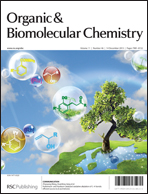Synthetic applications of arylboronic acid via an aryl radical transfer pathway
Abstract
The transition-metal-catalyzed functionalization of arylboronic acids is the most powerful tool for the formation of carbon–carbon and carbon–heteroatom bonds in modern organic synthesis. These transformations are generally considered to proceed via organometallic intermediates generated by transmetalation from the boronic acids. Interestingly, there is a novel recognition that arylboronic acids can serve as aryl radical precursors via oxidative carbon–boron bond cleavage in recent years. Manganese(III) acetate, Ag(I)/persulfate and iron(II or III)/persulfate catalytic systems have been shown to be effective for this transformation. In this review, recent advances in this new area are highlighted and their mechanisms are also discussed.


 Please wait while we load your content...
Please wait while we load your content...